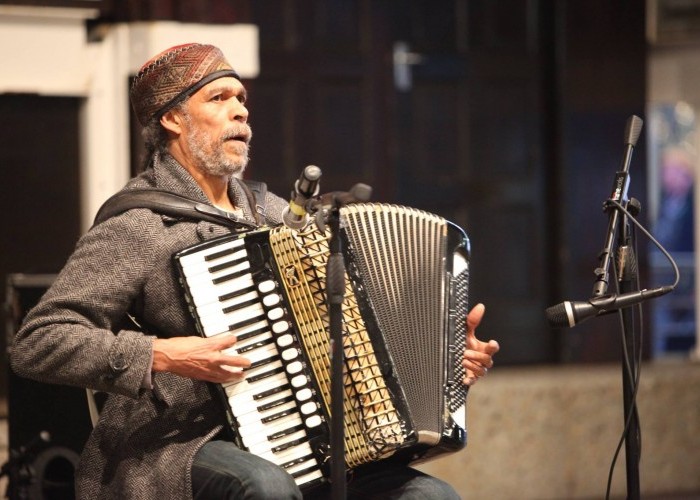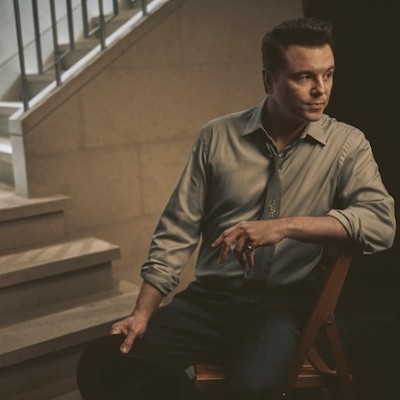Dec 9, 2025 12:28 PM
In Memoriam: Gordon Goodwin, 1954–2025
Gordon Goodwin, an award-winning saxophonist, pianist, bandleader, composer and arranger, died Dec. 8 in Los Angeles.…

Tony Cedras: 1952–2024
(Photo: Tania Keinhans)Multi-instrumentalist Tony Cedras died in Cape Town, South Africa, on Jan. 29. He had been suffering from chronic emphysema. Cedras played piano, guitar, trumpet, harmonium and, most notably, accordion. In a long career, he collaborated with some of the foremost jazz musicians in South Africa and the United States.
Cedras first made his name in Cape Town bands like Pacific Express, gigging or playing with local luminaries like Paul Abrahams, Jack Momple, Issy Ariefdien, Stephen Erasmus, Robbie Jansen, Winston Mankunku Ngozi, Jonathan Butler, Russell Herman and Stompie Manana. Like Cedras, Abrahams, Butler and Herman would leave South Africa eventually, settling mainly in the U.K. and the U.S. Once asked about his musical influences by a journalist, he listed his working-class Cape Town roots: church youth choirs (“singkoor”), “praise and worship” groups, Klopse (carnival troupes), a volunteer military band he joined as a young man and his mother’s “strong musical influence.”
By the 1980s, Cedras left South Africa and settled first in Botswana (where he was part of the Medu Arts Ensemble), then in London (where he joined the African National Congress’ Amandla Cultural Ensemble) and eventually in the U.S. He would tour with Hugh Masekela and Miriam Makeba, among others, which may be how he ended up playing with Paul Simon on the Graceland and Born At The Right Time tours. He would go on to record albums with Pharoah Sanders, Cassandra Wilson and Henry Threadgill.
One of Cedras and Threadgill’s memorable recordings together is “100 Year Old Game,” on the 1997 album Where’s Your Cup? (Columbia).
Cedras was born in 1952 and grew up in Elsies River, one of the oldest working-class and multiracial settlements in Cape Town, dating back to Dutch colonialism and slavery at the Cape. In the wake of apartheid and not long after Cedras’ birth, as the white government began to implement its segregation laws, it became a Coloured Group Area. Tony was from one of its more recognizable sections, “Lou se Bos,” where he picked up his early musical influences and training.
Cedras performed regularly at Madiba, a popular South African restaurant that is now closed, but on any night during the 2000s you might find him playing there and being joined by various musicians passing through the city.
In 2013, Cedras returned to South Africa,, where he recorded the album Love Letter To Cape Town, married, immersed himself in indigenous-rights politics and reconnected with old bandmates from the 1970s. DB

Goodwin was one of the most acclaimed, successful and influential jazz musicians of his generation.
Dec 9, 2025 12:28 PM
Gordon Goodwin, an award-winning saxophonist, pianist, bandleader, composer and arranger, died Dec. 8 in Los Angeles.…

Flea has returned to his first instrument — the trumpet — and assembled a dream band of jazz musicians to record a new album.
Dec 2, 2025 2:01 AM
After a nearly five-decade career as one of his generation’s defining rock bassists, Flea has returned to his first…

“It’s a pleasure and an honor to interpret the music of Oscar Peterson in his native city,” said Jim Doxas in regard to celebrating the Canadian legend. “He traveled the world, but never forgot Montreal.”
Nov 18, 2025 12:16 PM
In the pantheon of jazz luminaries, few shine as brightly, or swing as hard, as Oscar Peterson. A century ago, a…

Dec 11, 2025 11:00 AM
DownBeat presents a complete list of the 4-, 4½- and 5-star albums from 2025 in one convenient package. It’s a great…

Seth MacFarlane takes a turn from his television and film career to sing arrangements made for Frank Sinatra, but never recorded.
Nov 18, 2025 12:04 PM
“I’m not gonna lie to you — I don’t know why I thought this was about The Naked Gun, but I’m happy it’s…